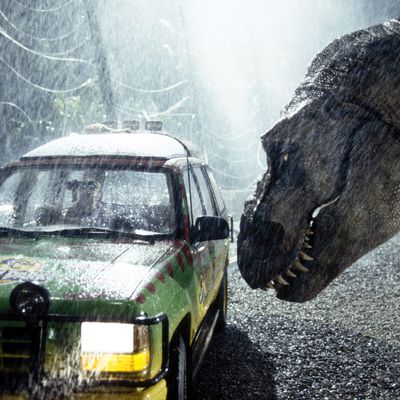
At times, you could swear Jurassic Park was meant to be in 3-D all along. A movie about a theme park that is, in many ways, its own theme-park ride, Steven Spielberg’s 1993 dinosaur adventure always had plenty of in-your-face moments that one associates with 3-D gimmickry — from a pack of gallimimus charging toward the camera, to a jeep falling off a tree and straight at us, or even to an ominous dolly into a prehistoric mosquito caught in amber. The movie hasn’t lost any of its charm in the twenty years since its release; if anything, it’s gained some, because those slick, seemingly perfect CGI dinosaurs now seem slightly more fake than they used to. You’d think that might be a hindrance, but not here: The same way that Raiders of the Lost Ark was partly an homage to the action serials of an earlier age, so too was Jurassic Park an homage to the creature features and monster movies of Spielberg’s youth. Now it feels like it’s about to join their ranks.
Actually, part of the reason why those dinosaurs now feel slightly off might actually be the 3-D itself: The retrofitting sometimes separates the monsters into their own spatial plane. The almost imperceptible electric edge between the effects and live-action footage suddenly feels more pronounced. But don’t worry: Jurassic Park hasn’t suddenly become tacky. The effects may have lost some of their novelty, but the movie itself has gained some surprising profundity in the intervening years.
Jurassic Park shows us a director in transition, and the film captures his transformation in its own kind of cinematic amber. Spielberg’s early career was defined by a series of films notable for their childlike vision of the world; now he was becoming a man who made films about fathers, about parental responsibility of both the literal and figurative kind. We can sense that tension directly in the gradual transformation of the film’s nominal hero, paleontologist Alan Grant (Sam Neill), from a child-hating grouch into a warm and cuddly hero and father figure to the film’s other two nominal heroes, Tim (Joseph Mazzello) and Lex Murphy (Ariana Richards), the young grandchildren of dinosaur-cloning theme-park impresario John Hammond (Richard Attenborough).
The film also has a bracing tendency to undercut itself. At first, the brightly colored jeeps, the red “Jurassic Park” helmets, the ornate, symphonic John Williams score, even the goofy animation that Hammond shows his park guests illustrating how his scientists cloned dinosaurs using ancient DNA, all promise a certain lightheartedness, a kid-friendly frivolity. (Even the characters’ guns seem a trifle too big — maybe suited more for action heroes than people.) But it all goes darker than expected: The dinosaurs wreck those yellow and green jeeps right good, just before eating some of the characters alive. It’s like E.T. has suddenly been taken over by Jaws. Does the 3-D help or hurt here? It’s a toss-up: The Tyrannosaurus rex attack, in the night and in the rain, has an additional unreality that adds a level of distance. But the later set piece, with the raptors loose in the Jurassic Park kitchen, now has an added element of menace.
Of course, all of that how-does-it-play-twenty-years-later talk is a bit of a gimmick in itself. Jurassic Park never really went away. The intervening years gave us two sequels, all of which pop up incessantly on cable, and lots of movies have borrowed from it along the way. But what’s perhaps most remarkable about it now — aside from the thrills, which are still there — is how, slightly deprived of its unimpeachable, high-tech newness, it feels more clearly personal, more like the work of an artist pushing his relationship with an (immense) audience. Watching it, we can sense Spielberg trying his damnedest to take this wide-eyed blockbuster into curiously dark corners. He would display that same darkness — a kind of glorious sadism, really — in Jurassic Park’s much-maligned, underrated sequel The Lost World. (We also saw it in the earlier Indiana Jones and the Temple of Doom, the movie that helped invent the PG-13 rating.) The real reason Jurassic Park still works so well is that it was made by a filmmaker who knows that, sometimes, art — even of the ultimately reassuring, box-office-friendly kind — has to hurt us a little bit to make a real impact.


